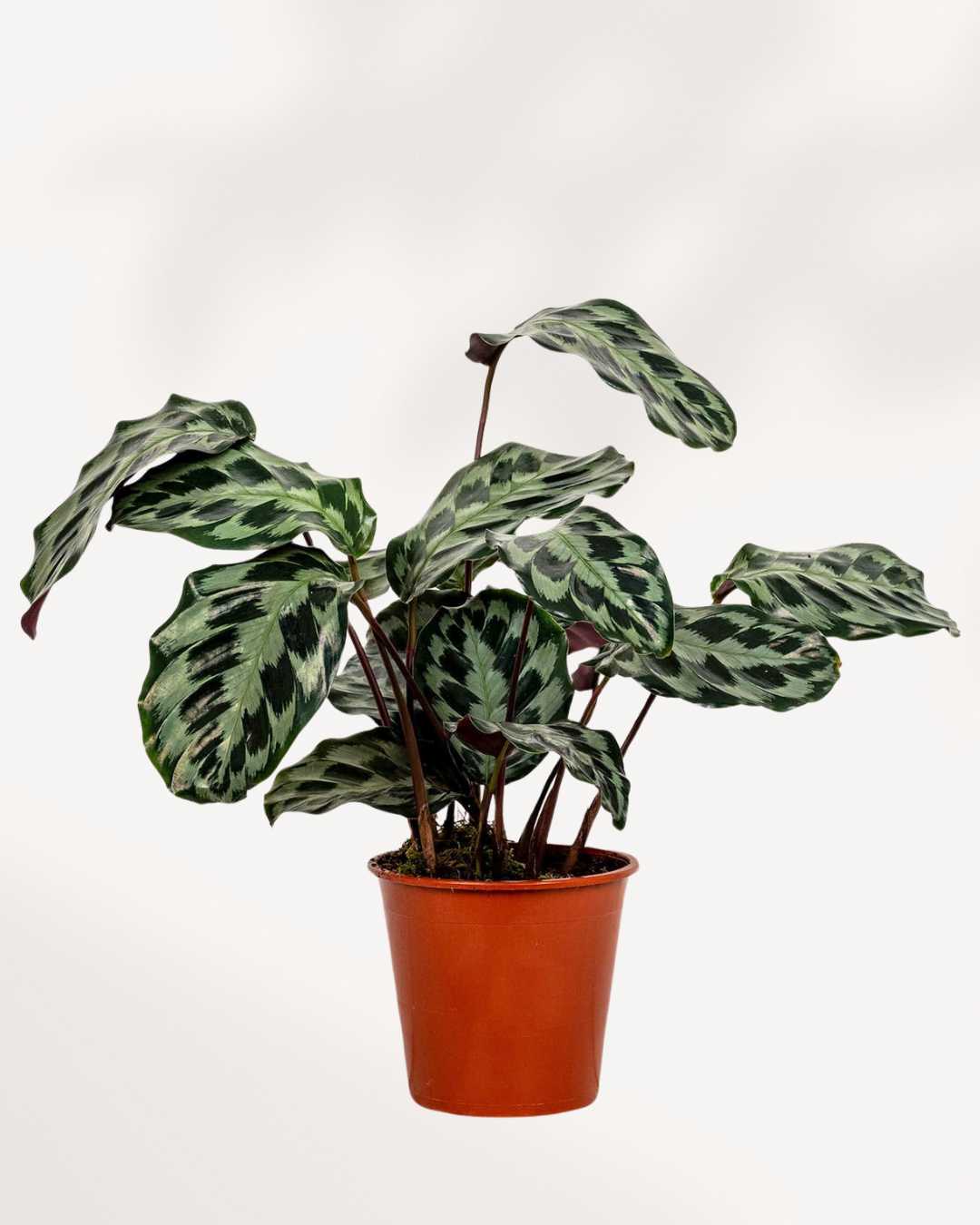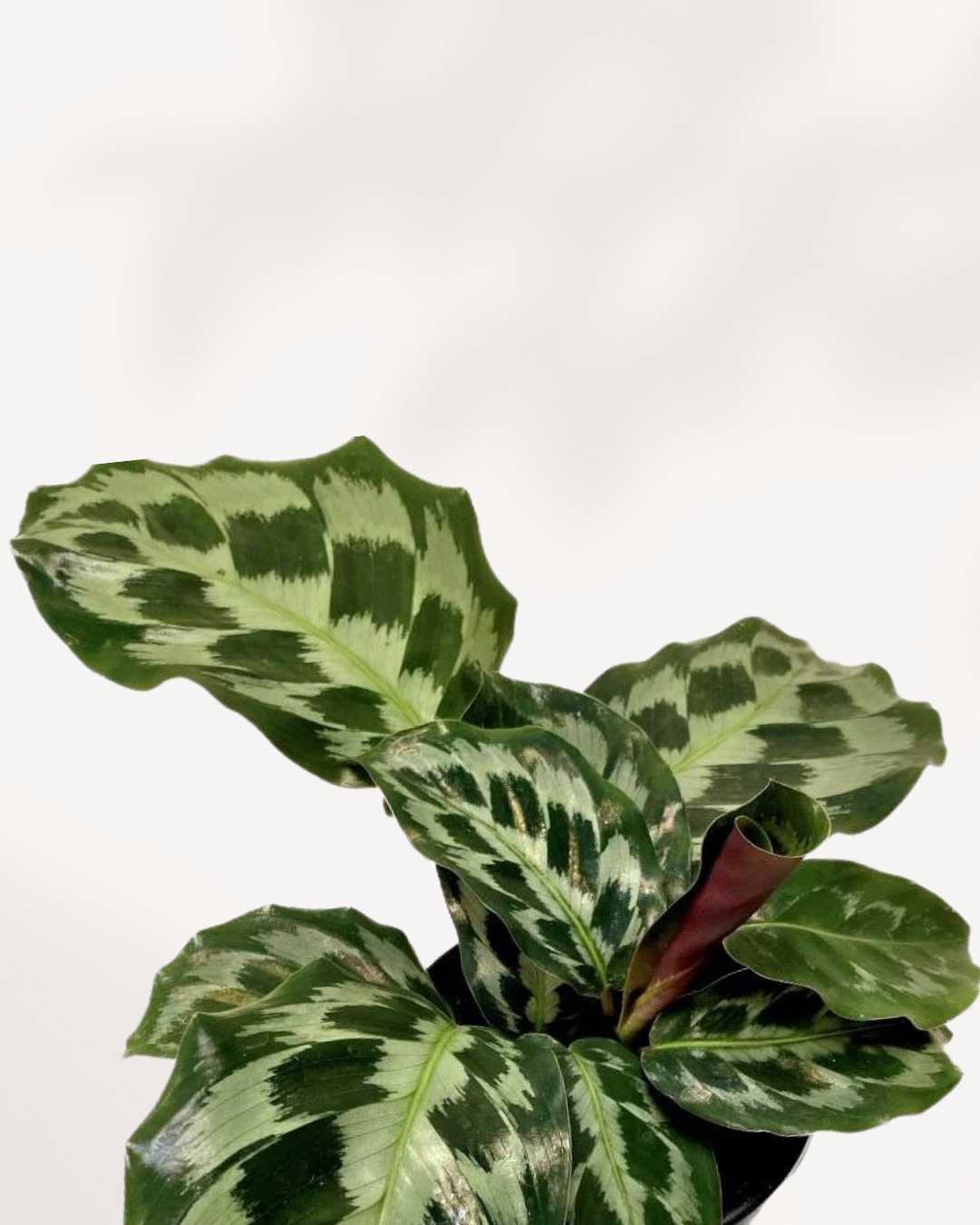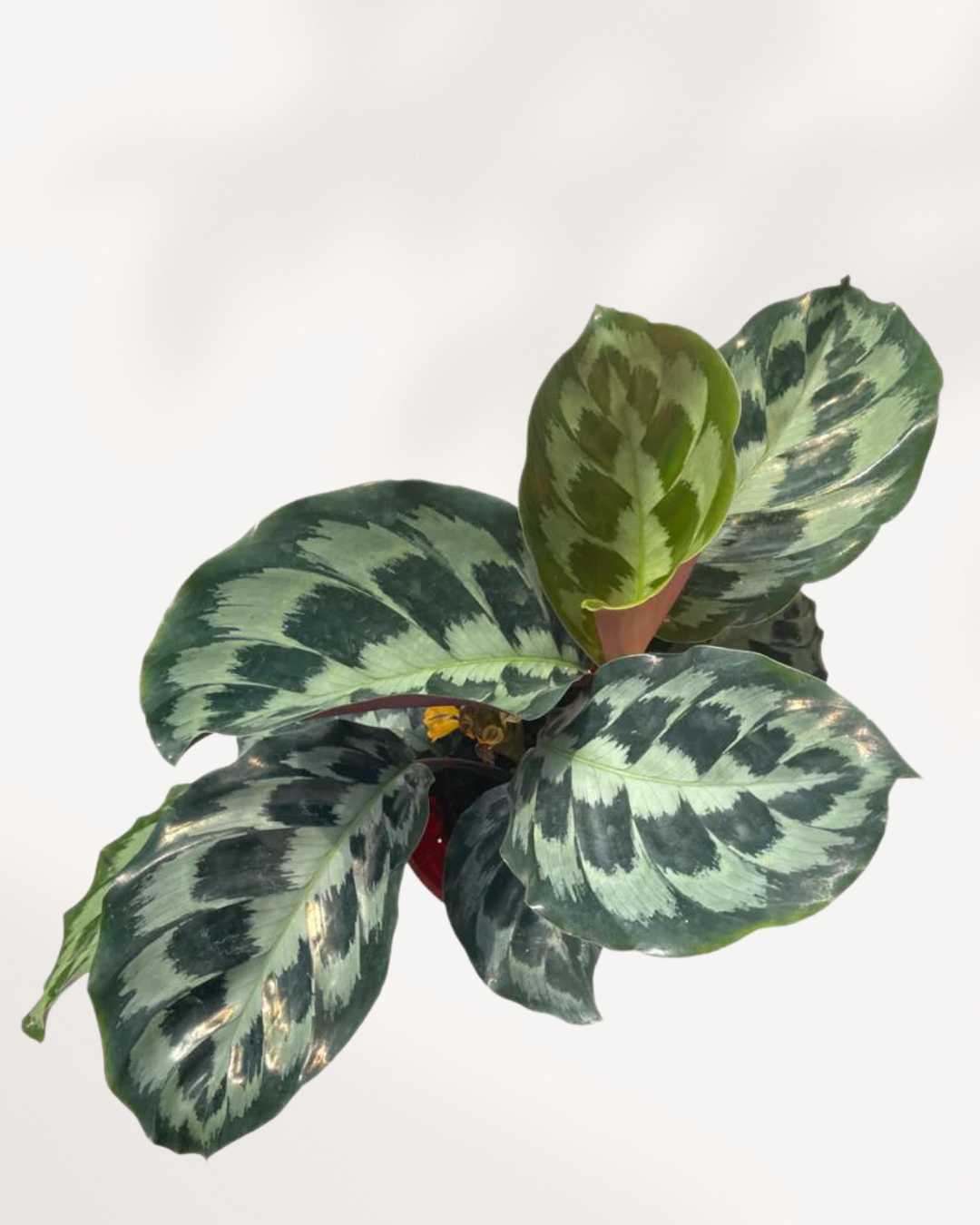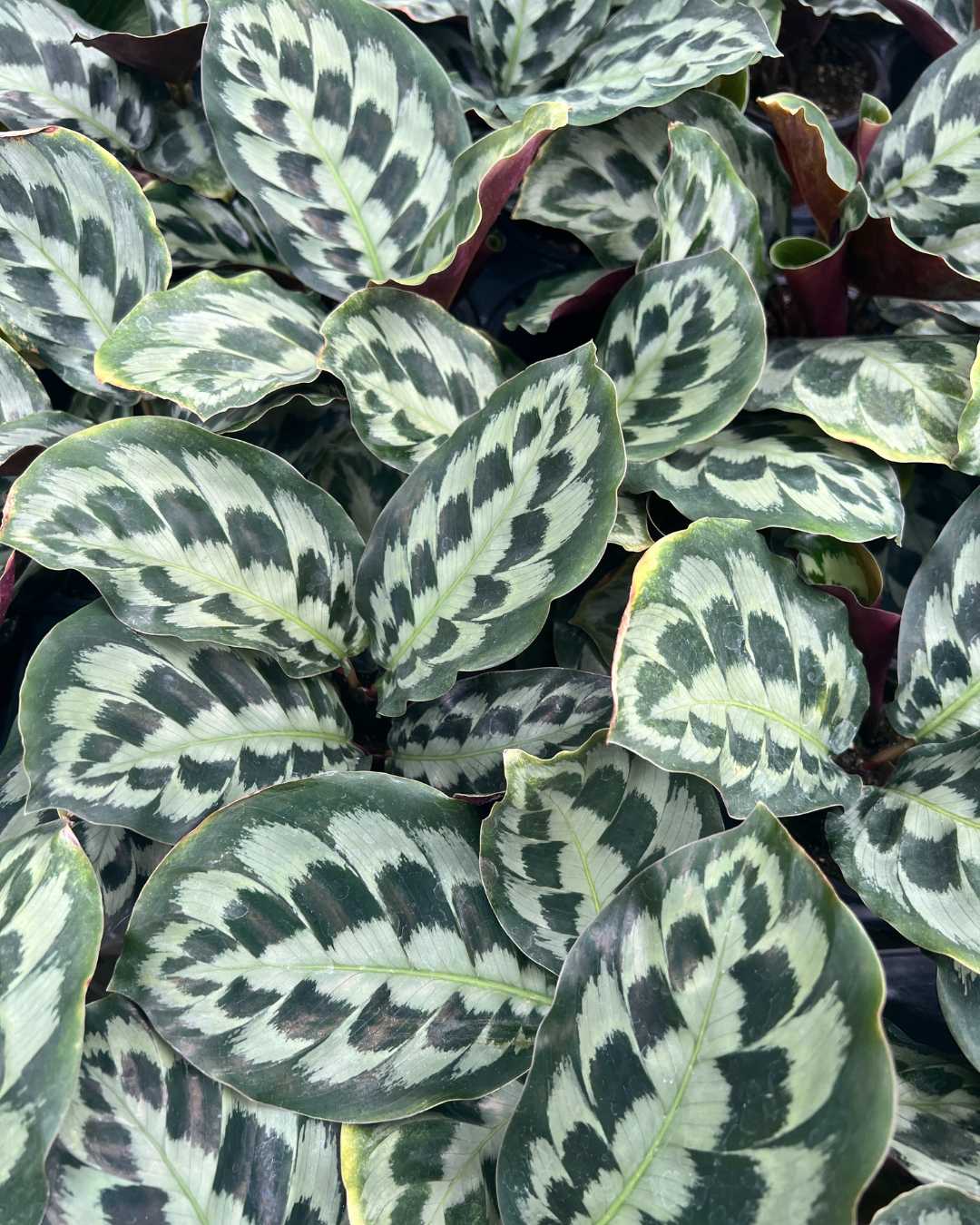Couldn't load pickup availability
Calathea Helen Kennedy, admired for its lush, vibrant foliage, is a striking houseplant that enhances the aesthetic of any indoor space. Known for its broad, deep green leaves with intricate patterns, this plant is perfect for plant enthusiasts seeking a low-maintenance but visually appealing addition to their collection. Native to tropical rainforests, the Calathea Helen Kennedy thrives in warm, humid environments and indirect light.
Common Names
- Helen Kennedy Calathea
- Prayer Plant
Botanical Classification
- Kingdom: Plantae
- Order: Zingiberales
- Family: Marantaceae
- Genus: Calathea
Native Habitat
Calathea Helen Kennedy is native to the tropical rainforests of South America, where it grows as an understory plant. In its natural habitat, it thrives in high humidity and dappled sunlight, conditions that can be mimicked indoors for optimal growth.
Historical and Cultural Significance
The Calathea Helen Kennedy is part of a larger family of Prayer Plants, named for their unique leaf movements. These plants fold their leaves upward at night, a phenomenon known as nyctinasty. This fascinating behavior and the intricate beauty of their leaves have made Calatheas a popular choice among houseplant enthusiasts worldwide.
Uses and Popularity
Calathea Helen Kennedy is highly valued for its decorative appeal and air-purifying qualities. Its compact growth habit and vibrant foliage make it a favorite for homes, offices, and other indoor spaces where it adds a touch of tropical elegance.
Description
Physical Characteristics
Calathea Helen Kennedy features large, oval-shaped leaves with a velvety texture and striking patterns. The foliage ranges from deep green to lighter shades, with intricate veins that create a mesmerizing effect.
Growth Habit
This plant grows in a bushy, upright manner and typically reaches a height of 1 to 2 feet indoors. It thrives in bright, indirect light and appreciates consistent humidity for healthy growth.
Popular Calathea Varieties
Calathea Musaica Network
- Known for its unique, mosaic-like leaf patterns.
Calathea Freddie
- Features light and dark green striped leaves for a bold look.
Calathea Ornata Pinstripe
- Characterized by its dark green leaves with pink pinstripes.
Calathea Leopordina
- Distinguished by its bold, elliptical leaves with dark green markings.
Calathea Roseopicta Dottie
- Noted for its deep purple leaves outlined in pink.
Care Guide
Light Requirements
Calathea Helen Kennedy thrives in bright, indirect light but can tolerate low-light conditions. Avoid direct sunlight, as it can scorch the delicate leaves. Learn More about Plant Light Requirements
Watering Needs
Water when the top inch of soil feels dry. Use filtered or distilled water to avoid leaf damage from mineral buildup. Indoor Plant Watering Guide
Soil Preferences
Use a well-draining, peat-based potting mix with some perlite to ensure aeration and proper drainage. Indoor Plant Potting Mix
Humidity
Calathea Helen Kennedy thrives in high humidity levels (60%-80%). Use a humidifier or place the plant near a water tray with pebbles to maintain consistent moisture.
Common Pests
Spider Mites
Spider mites can cause stippling on leaves. Regular misting and maintaining high humidity can help prevent infestations. Learn More
Mealybugs
These pests appear as white, cottony masses on the leaves and stems. Treat with a cotton swab dipped in rubbing alcohol. Learn More
FAQs
How often should I water my Calathea Helen Kennedy?
Water when the top inch of soil feels dry. Avoid overwatering and ensure the pot has proper drainage.
Does Calathea Helen Kennedy need high humidity?
Yes, high humidity (60%-80%) is essential for this plant. Use a humidifier or mist the plant regularly.
Why are the edges of my Calathea Helen Kennedy turning brown?
Brown edges are often a sign of low humidity or exposure to hard water. Increase humidity and use distilled water for watering.
Can I grow Calathea Helen Kennedy in low light?
Yes, this plant tolerates low light but thrives best in bright, indirect light for vibrant foliage.
How to take care of Calathea Helen Kennedy
Light: Medium - Bright
Light: Medium - Bright
Sun: Indirect
Sun: Indirect
Water: When half dry
Water: When half dry
Humidity: High
Humidity: High
Pet Friendly: Yes
Pet Friendly: Yes
Pro Tip
Pro Tip
Delivery Policy for Plant Condition
Delivery Policy for Plant Condition
"I have only received part of my order. What to do?
No worries if you've only got part of your order! Our plants come from different nurseries and might arrive in separate shipments, typically 1-2 days apart. It's all part of ensuring your green friends reach you in top-notch condition!
If you do not receive the remaining packages within 48 hours contact support at info@mygreenscape.ca
What is the Life Time Support?
Absolutely! Lifetime support means you can count on us whenever you have questions or uncertainties about your plant. Whether you're puzzled by its behavior or just want to ensure it's thriving, we're here for you. Connect with us on Instagram @mygreenscapeto or shoot us an email at support@mygreenscape.ca.
When it comes to our guarantee for plants shipped with standard or express, rest assured that we offer a 30-day happy healthy plant guarantee on all such shipments. This ensures that your plants are covered for 30 days after delivery, giving you peace of mind regarding their condition. If you have any concerns within this period, feel free to reach out to us for assistance.
For further details, please visit our Local Delivery, Store Pickup, Standard Shipping Guide Page.
What to expect
What to expect
Your plant will arrive in a standard nursery pot, typically 0.5" - 1" smaller than the stated size to seamlessly fit into your chosen decorative pot. Washable Paper Planter Bags are available for separate purchase.
Just like nature intended, each plant is unique, showcasing natural variations in size, shape, and characteristics. Our commitment is to deliver a plant that closely resembles the one featured on our website, matching your chosen size, and with the potential to thrive happily in your home.
Frequently Asked Questions
Frequently Asked Questions
Certainly! If you're pondering about ordering plants online, you're not alone. We've compiled the most frequently asked questions. Check out our FAQ section here for quick answers! Happy planting!
Plant & Pot Size Chart
Plant & Pot Size Chart
Choosing the right pot size for your plants can be a daunting task, especially if you're new to gardening. But fear not! Our pot sizes chart can help you find the perfect match for your plants, ensuring they have enough space to grow and thrive. With our guide, you'll be able to confidently choose the right pot size and plant variety for your gardening needs.
Plant Pot Size Guide.

| Extra Small | 7-10 cm | 2.5 - 3 inches |
| Small | 11-12 cm | 3.5 - 4 inches |
| Medium | 14-17 cm | 5 - 6 inches |
| Large | 19-21 cm | 8 - 10 inches |
| Extra Large | 24-27 cm | 12 - 14 inches |
All sizes are specified in product details.
Your Complete Guide to Pot Sizes: What Size Should You Choose?

When selecting a pot for your plant, it's important to find the right size. But with all the different options out there, how do you know which one is best? We're here to help!
MyGreenscape's pot sizes chart is a great resource for finding your perfect fit. Our easy-to-read chart takes out all the guesswork and helps you quickly choose the right size for your plant.
Smaller pots are best for seedlings or small plants just starting out. These tend to be shallow but wide, allowing enough room for the roots of the young plant but not too much where they get overcrowded. Medium-sized pots are ideal when your plant has grown from its infancy and is ready for more space. These are deeper and wider than small pots, so that it can accommodate larger root systems - making sure your plant gets enough nourishment while still giving it breathing room. Large pots are top choice if you have an established plant in need of lots of space - think trees and large shrubs! The spacious depth and width allow plenty of room for deep root systems without struggling for air or light.
No matter what size you choose, MyGreenscape has got you covered, with our pot sizes chart guaranteeing you find the perfect fit every time!
Winter Shipping Protection
Winter Shipping Protection
We take extra care with each package during the colder months. For destinations experiencing cold weather, we provide insulated packaging and heat packs as needed to protect your plants from freezing temperatures. With Winter Shipping Protection, your plants are equipped to arrive safe and sound, even in winter’s chill.
Care Guide
Care Guide
Explore essential care tips. check out our Comprehensive Resource for Indoor Plant Care.




WATERING MADE EASY
Check soil moisture before watering and use a potting mix that drains well. It’s the secret to healthy, happy plants!
Hear From Happy Plant Parents.
Who have brought Mygreenscape plants into their homes.


















